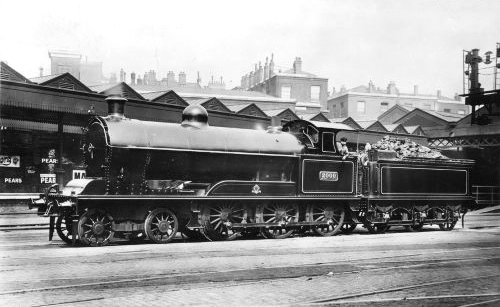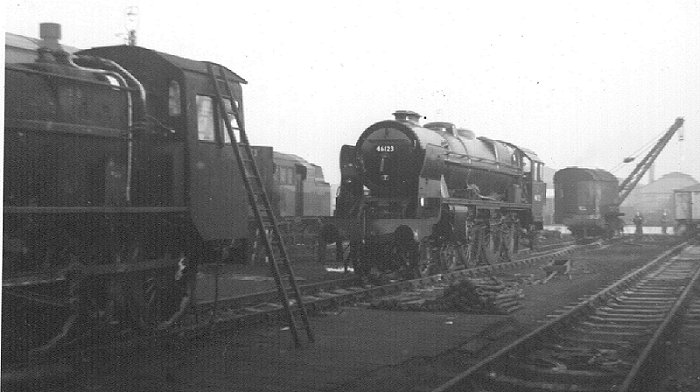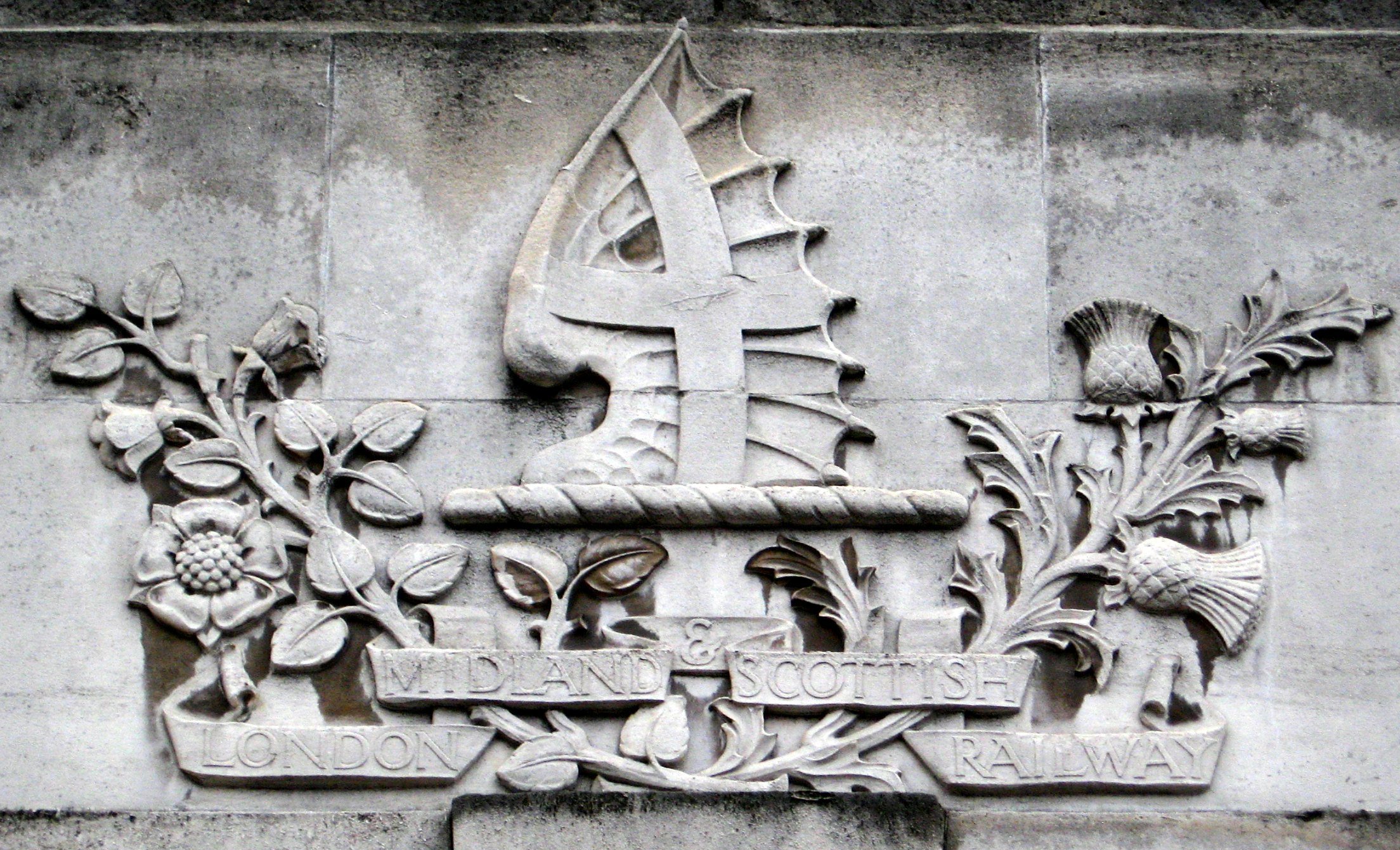|
LNWR 19in Express Goods Class
The London and North Western Railway (LNWR) 19in Express Goods Class, otherwise known as the Experiment Goods Class was a class of 4-6-0 steam locomotives. They were essentially a smaller wheeled version of the Whale's Experiment Class and were an early attempt at a mixed traffic engine. Career Crewe built 170 engines between 1906 and 1909. The LNWR reused numbers from withdrawn locomotives, so the numbering was haphazard. All passed onto LMS ownership in 1923. The LMS gave them the power classification A number of different numbering and classification schemes were used for the locomotives owned by the London, Midland and Scottish Railway (LMS) and its constituent companies; this page explains the principal systems that were used. The followi ... 4F. The LMS renumbered them into the more logical series 8700–8869. Withdrawals started in 1931. British Railways acquired three 8801/24/34 in 1948, but all were withdrawn by 1950 before they could receive their alloca ... [...More Info...] [...Related Items...] OR: [Wikipedia] [Google] [Baidu] |
Photographic Grey
Photographic grey, also known as works grey, was a paint scheme commonly applied to steam locomotives during the period before colour photography became commonplace. It was applied to allow sharper, more detailed images of the locomotive to be recorded. The first photographs of railways and their locomotives were made by private individuals, but by the 1860s the railway companies themselves were keen to create official photographs of the highest quality possible of their latest designs, which led to the adoption of photographic grey in railway photography. Use Railway companies wished to record their latest locomotives for use in publicity material and advertisements, and as a technical record of their work. This was especially the case in the United Kingdom, where all but the smallest of the 'pre-grouping' companies owned their own locomotive works and designed and built their own railway engines. For the numerous private locomotive builders it was especially important to h ... [...More Info...] [...Related Items...] OR: [Wikipedia] [Google] [Baidu] |
George Whale
George Whale (7 December 1842 – 7 March 1910) was an English locomotive engineer who was born in Bocking, Essex, and educated in Lewisham, London. He worked for the London and North Western Railway (LNWR). Career In 1858 he entered the LNWR's Wolverton Works under James Edward McConnell, and when in 1862 the LNWR Board decided to concentrate locomotive construction and repair at Crewe Works under John Ramsbottom, Whale was one of around 400 workers transferred from Wolverton to Crewe. In 1865 he entered the drawing office at Crewe Works, and in 1867 joined the LNWR running department under J. Rigg. In 1898 he was made responsible for the running of all LNWR locomotives. Francis William Webb, the LNWR Locomotive Superintendent, gave twelve months notice of retirement to the LNWR Board in November 1902. On 22 April 1903, the Board announced that Whale had been chosen to succeed Webb, who was to retire at the end of July 1903. Webb's health was failing, and Whale soon took up ... [...More Info...] [...Related Items...] OR: [Wikipedia] [Google] [Baidu] |
Crewe Works
Crewe Works is a British railway engineering facility located in the town of Crewe, Cheshire. The works, which was originally opened by the Grand Junction Railway in 1840, employed around 7,000 to 8,000 workers at its peak. In the 1980s, a lot of the engineering works were closed. Much of the site has been redeveloped but the remaining parts are owned and operated by French-owned multinational rolling stock manufacturer, Alstom SA. During the late 19th century, the London and North Western Railway used Crewe Works to produce many famous locomotives such as the Webb Jumbo class and the compounds, the Whale Experiment and Precursor classes, and the Bowen-Cooke Claughtons. In particular, Whale's 1912 superheated G1 Class developed from a locomotive introduced by Webb in 1892, lasted, in many cases until 1964, near the end of steam in 1968. After grouping, the works were taken over by London, Midland and Scottish Railway which was the successor to the LNWR. It was d ... [...More Info...] [...Related Items...] OR: [Wikipedia] [Google] [Baidu] |
4-6-0
A 4-6-0 steam locomotive, under the Whyte notation for the classification of steam locomotives by wheel arrangement, has four leading wheels on two axles in a leading bogie and six powered and coupled driving wheels on three axles with the absence of trailing wheels. In the mid-19th century, this wheel arrangement became the second-most-popular configuration for new steam locomotives in the United States, where this type is commonly referred to as a ten-wheeler.White, John H., Jr. (1968). ''A history of the American locomotive; its development: 1830-1880''. New York, NY: Dover Publications. p. 57. As locomotives pulling trains of lightweight all-wood passenger cars from the 1890 to the 1920s, they were exceptionally stable at near speeds on the New York Central's New York-to-Chicago Water Level Route and on the Reading Railroad's line from Camden to Atlantic City, New Jersey. Overview Tender locomotives During the second half of the nineteenth and first half of the twentieth ... [...More Info...] [...Related Items...] OR: [Wikipedia] [Google] [Baidu] |
London And North Western Railway
The London and North Western Railway (LNWR, L&NWR) was a British railway company between 1846 and 1922. In the late 19th century, the L&NWR was the largest joint stock company in the United Kingdom. In 1923, it became a constituent of the London, Midland and Scottish (LMS) railway, and, in 1948, the London Midland Region of British Railways: the LNWR is effectively an ancestor of today's West Coast Main Line. History The company was formed on 16 July 1846 by the amalgamation of the Grand Junction Railway, London and Birmingham Railway and the Manchester and Birmingham Railway. This move was prompted, in part, by the Great Western Railway's plans for a railway north from Oxford to Birmingham. The company initially had a network of approximately , connecting London with Birmingham, Crewe, Chester, Liverpool and Manchester. The headquarters were at Euston railway station. As traffic increased, it was greatly expanded with the opening in 1849 of the Great Hall, design ... [...More Info...] [...Related Items...] OR: [Wikipedia] [Google] [Baidu] |
London, Midland And Scottish Railway
The London, Midland and Scottish Railway (LMSIt has been argued that the initials LMSR should be used to be consistent with LNER, GWR and SR. The London, Midland and Scottish Railway's corporate image used LMS, and this is what is generally used in historical circles. The LMS occasionally also used the initials LM&SR. For consistency, this article uses the initials LMS.) was a British railway company. It was formed on 1 January 1923 under the Railways Act of 1921, which required the grouping of over 120 separate railways into four. The companies merged into the LMS included the London and North Western Railway, Midland Railway, the Lancashire and Yorkshire Railway (which had previously merged with the London and North Western Railway on 1 January 1922), several Scottish railway companies (including the Caledonian Railway), and numerous other, smaller ventures. Besides being the world's largest transport organisation, the company was also the largest commercial enter ... [...More Info...] [...Related Items...] OR: [Wikipedia] [Google] [Baidu] |
British Railways
British Railways (BR), which from 1965 traded as British Rail, was a state-owned company that operated most of the overground rail transport in Great Britain from 1948 to 1997. It was formed from the nationalisation of the Big Four (British railway companies), Big Four British railway companies, and was privatisation of British Rail, privatised in stages between 1994 and 1997. Originally a trading brand of the Railway Executive of the British Transport Commission, it became an independent statutory corporation in January 1963, when it was formally renamed the British Railways Board. The period of nationalisation saw sweeping changes in the railway. A process of dieselisation and Railway electrification in Great Britain, electrification took place, and by 1968 steam locomotives had been entirely replaced by diesel and electric traction, except for the Vale of Rheidol Railway (a narrow-gauge railway, narrow-gauge tourist line). Passenger train, Passengers replaced freight train, ... [...More Info...] [...Related Items...] OR: [Wikipedia] [Google] [Baidu] |
LNWR Engine No
The London and North Western Railway (LNWR, L&NWR) was a British railway company between 1846 and 1922. In the late 19th century, the L&NWR was the largest joint stock company in the United Kingdom. In 1923, it became a constituent of the London, Midland and Scottish (LMS) railway, and, in 1948, the London Midland Region of British Railways: the LNWR is effectively an ancestor of today's West Coast Main Line. History The company was formed on 16 July 1846 by the amalgamation of the Grand Junction Railway, London and Birmingham Railway and the Manchester and Birmingham Railway. This move was prompted, in part, by the Great Western Railway's plans for a railway north from Oxford to Birmingham. The company initially had a network of approximately , connecting London with Birmingham, Crewe, Chester, Liverpool and Manchester. The headquarters were at Euston railway station. As traffic increased, it was greatly expanded with the opening in 1849 of the Great Hall, designed by P ... [...More Info...] [...Related Items...] OR: [Wikipedia] [Google] [Baidu] |
Steam Locomotive
A steam locomotive is a locomotive that provides the force to move itself and other vehicles by means of the expansion of steam. It is fuelled by burning combustible material (usually coal, oil or, rarely, wood) to heat water in the locomotive's boiler to the point where it becomes gaseous and its volume increases 1,700 times. Functionally, it is a steam engine on wheels. In most locomotives, the steam is admitted alternately to each end of its cylinders, in which pistons are mechanically connected to the locomotive's main wheels. Fuel and water supplies are usually carried with the locomotive, either on the locomotive itself or in a tender coupled to it. Variations in this general design include electrically-powered boilers, turbines in place of pistons, and using steam generated externally. Steam locomotives were first developed in the United Kingdom during the early 19th century and used for railway transport until the middle of the 20th century. Richard Trevithi ... [...More Info...] [...Related Items...] OR: [Wikipedia] [Google] [Baidu] |
LNWR Whale Experiment Class
The London and North Western Railway (LNWR) Experiment Class was a class of 4-6-0 steam locomotive designed by George Whale. Career They were an extended version of the Whale's Precursor Class 4-4-0, with slightly smaller driving wheels. The first of the class, 66 ''Experiment'' was built in 1905 and a total of 105 were constructed up until 1910. The LNWR reused numbers and names of withdrawn locomotives, with the result that the numbering system was completely haphazard. A 19in Express Goods Class with smaller driving wheels was also built from 1906. From 1911, a superheated version, the Prince of Wales Class was built. In 1915, 1361 ''Prospero'' was experimentally rebuilt with four cylinders, Dendy Marshall valve gear and superheated. The conversion was not repeated. Only two other engines were given superheaters; 2624 ''Saracen'' and 1993 (LMS 5472) ''Richard Moon''. All entered London, Midland and Scottish Railway (LMS) stock upon grouping in 1923. The LMS gave the ... [...More Info...] [...Related Items...] OR: [Wikipedia] [Google] [Baidu] |
Mixed-traffic Locomotive
A locomotive or engine is a rail transport vehicle that provides the motive power for a train. If a locomotive is capable of carrying a payload, it is usually rather referred to as a multiple unit, motor coach, railcar or power car; the use of these self-propelled vehicles is increasingly common for passenger trains, but rare for freight (see CargoSprinter). Traditionally, locomotives pulled trains from the front. However, push-pull operation has become common, where the train may have a locomotive (or locomotives) at the front, at the rear, or at each end. Most recently railroads have begun adopting DPU or distributed power. The front may have one or two locomotives followed by a mid-train locomotive that is controlled remotely from the lead unit. __TOC__ Etymology The word ''locomotive'' originates from the Latin 'from a place', ablative of 'place', and the Medieval Latin 'causing motion', and is a shortened form of the term ''locomotive engine'', which was first u ... [...More Info...] [...Related Items...] OR: [Wikipedia] [Google] [Baidu] |







.jpg)

